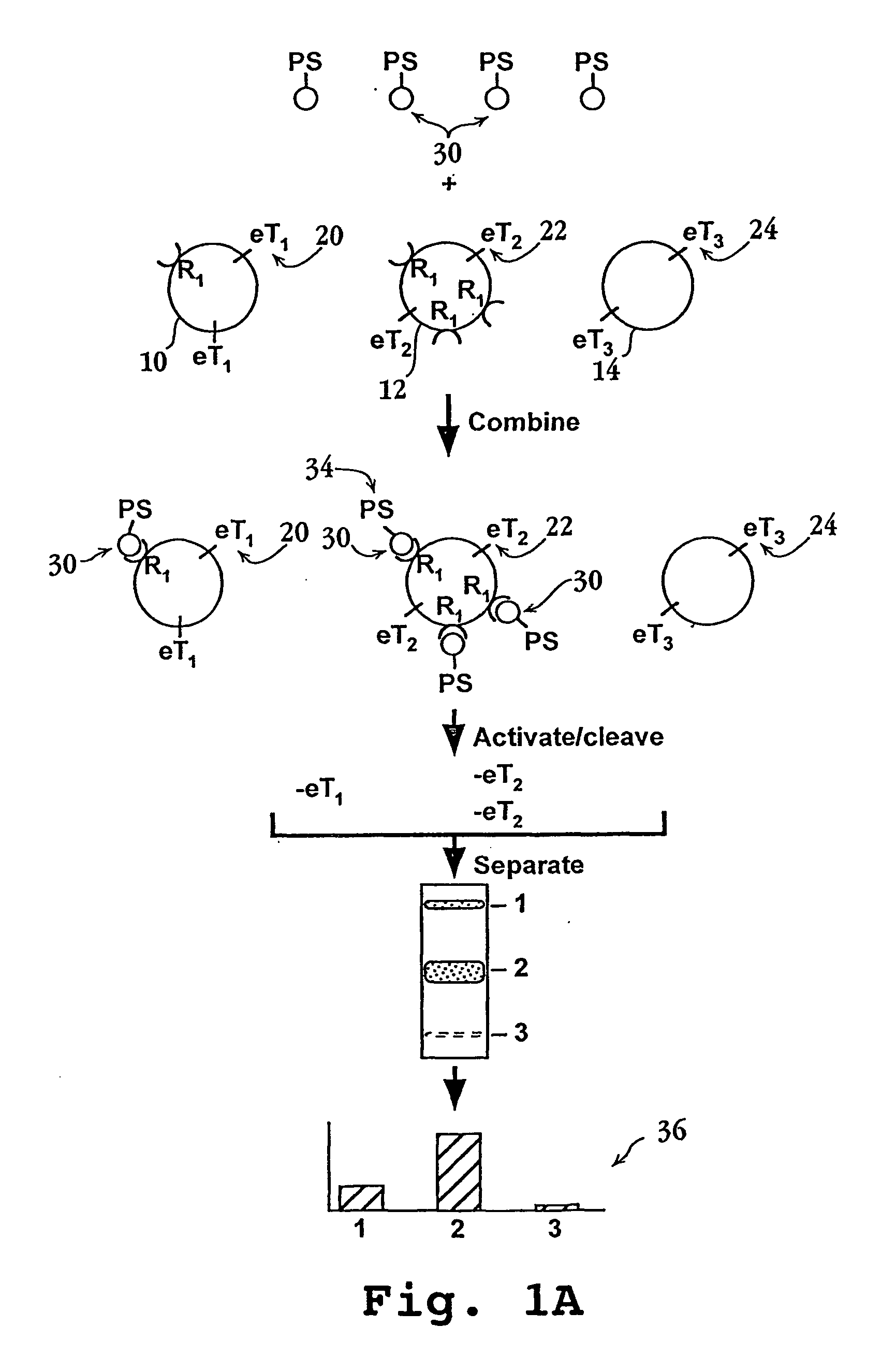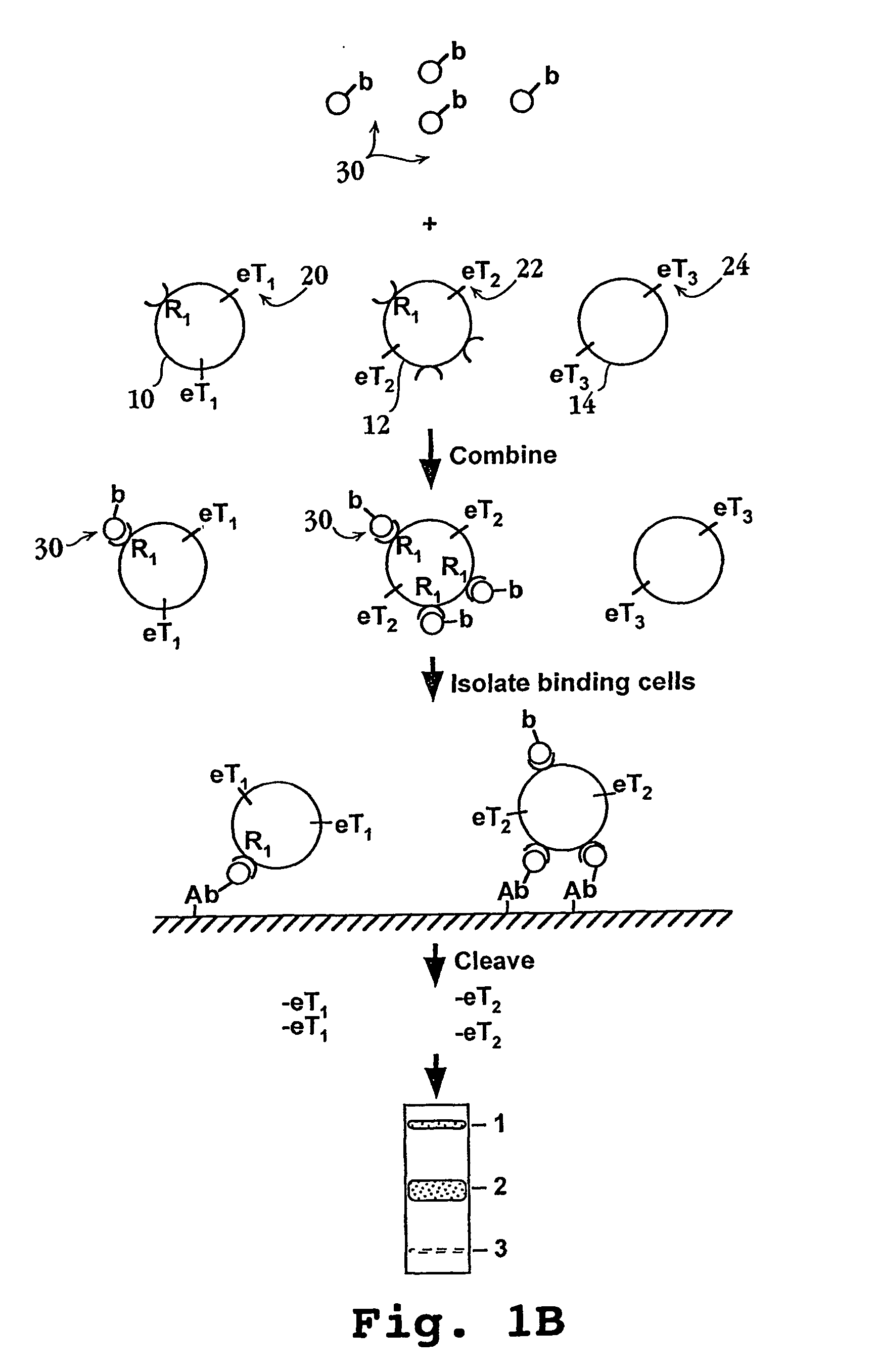Methods and compositions for screening cell binding molecules
- Summary
- Abstract
- Description
- Claims
- Application Information
AI Technical Summary
Benefits of technology
Problems solved by technology
Method used
Image
Examples
example 1
Synthesis of eTags with Lipid Anchors
[0251] A. “Pro28-amide” (see FIG. 11A)
[0252] Reaction of 5-carboxyfluorescein with N-hydroxysuccinimide (NHS) and 1,3-dicyclohexylcarbodiimide (DCC) in DMF gave the corresponding NHS ester, which was then treated with ethylenediamine. The resulting amine was reacted with α-bromophenylacetic acid NHS ester to afford the desired α-bromo derivative 1 (see FIG. 11A). Treatment of 1 with 11-mercaptoundecanoic acid and ET3N in DMF provided the acid 2. Finally, conversion of 2 to its NHS ester followed by reaction with dioctadecylamine gave the target structure Pro28-amide, also referred to herein as Pro28.
[0253] B. “Pro29-amide” (see FIG. 11B)
[0254] Reaction of 5-aminofluorescein with α-bromophenylacetyl chloride (prepared by treating α-bromophenylacetic acid with oxalyl chloride) gave the bromo compound 3 (see FIG. 11B), which was then reacted with 3-mercaptopropanoic acid and triethylamine in DMF. The resulting α-thioacid 4 was finally converted,...
example 2
Conjugation of Streptavidin with Al-Phthalocyanine Tetrasulfonic Acid
[0257] To 3 mL of 17 mg / mL streptavidin in 33 mM Borax was added 65 μL of 46 mg / mL (42 nmol / μL) of Al-Phthalocyanine tetrasulfonic acid hexanoate NHS ester in DMF. The mixture was incubated for 16 hours in the dark at 4° C. Separation of conjugated and non-conjugated Al-Phthalocyanine tetrasulfonic acid (PcS) was performed on 1.5×46 cm Sepharose CL-6B equilibrated in 1×PBS. Analysis of the produce showed that about 3 PcS (sensitizer) molecules were conjugated per streptavidin molecule (using A280=3.0 for 1 mg / mL StAv and ε=180,000 for PcS).
example 3a
Linking of Photosensitizer to Des-Biotin Derivative (FIG. 12A)
[0258] To a dry 100 mL round bottom flask fitted with a stir bar was added aluminum phthalocyanine tetrasulfonyl chloride (150 mg, 0.15 mmol). Anhydrous THF (10 mL) was added to dissolve the compound. Desthiobiotin amine (50 mg, 0.16 mmol), dissolved in 0.5 mL of DMF, was added to the reaction flask, followed by triethylamine (0.2 mL). The reaction was stirred at room temperature for 16 hrs, then quenched with potassium carbonate solution (1 mL, 10% solution). Stirring was continued for 1 hour. Solvent was removed, and the product was purified by reverse phase column chromatography, eluting with acetonitrile-water (20%). Homogeneous fractions were pooled, and the solvent was removed to obtain the desthiobiotinylated phthalocyanine (FIG. 12A) (Al PcS-DES Biotin; 14.2 mg). TLC: rev. phase, Rf, 0.5 (acetonitrile, water, 5:3)
PUM
| Property | Measurement | Unit |
|---|---|---|
| Fraction | aaaaa | aaaaa |
| Fraction | aaaaa | aaaaa |
| Area | aaaaa | aaaaa |
Abstract
Description
Claims
Application Information
 Login to View More
Login to View More - R&D
- Intellectual Property
- Life Sciences
- Materials
- Tech Scout
- Unparalleled Data Quality
- Higher Quality Content
- 60% Fewer Hallucinations
Browse by: Latest US Patents, China's latest patents, Technical Efficacy Thesaurus, Application Domain, Technology Topic, Popular Technical Reports.
© 2025 PatSnap. All rights reserved.Legal|Privacy policy|Modern Slavery Act Transparency Statement|Sitemap|About US| Contact US: help@patsnap.com



